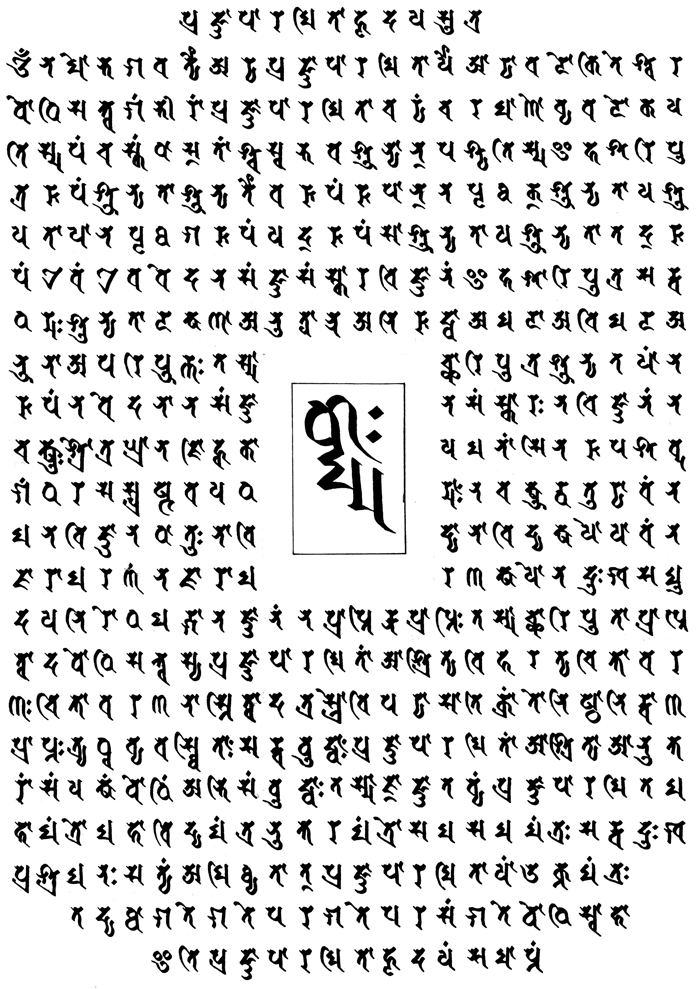Prajñāpāramita-hṛdayam Sūtra - The Heart Sutra
The Heart Sutra is one of the best known, most chanted, of all sutras. It exists in a longer and a shorter form - the calligraphy here is of the shorter version. There are a number of standard commentaries on this sutra, which look at it from a variety of traditional view points. Versions are known in most of the important languages of Mahāyāna Buddhism.
Here is my Siddhaṃ calligraphy of the Sanskrit (following Edward Conze's Sanskrit edition as it appears in his book Buddhist Wisdom Books). See also my separate page for the Heart Sūtra mantra
prajñāpāramita-hṛdayam sūtra
oṃ namo bhagavatyai ārya prajñāpāramitāyai!
ārya-avalokiteśvaro bodhisattvo gambhīrāṃ prajñāpāramitā caryāṃ caramāṇo vyavalokayati sma: panca-skandhās tāṃś ca svābhava śūnyān paśyati sma.
iha śāriputra: rūpaṃ śūnyatā śūnyataiva rūpaṃ; rūpān na pṛthak śūnyatā śunyatāyā na pṛthag rūpaṃ; yad rūpaṃ sā śūnyatā; ya śūnyatā tad rūpaṃ. evam eva vedanā saṃjñā saṃskāra vijñānaṃ.
iha śāriputra: sarva-dharmāḥ śūnyatā-lakṣaṇā, anutpannā aniruddhā, amalā avimalā, anūnā aparipūrṇāḥ.
tasmāc chāriputra śūnyatayāṃ na rūpaṃ na vedanā na saṃjñā na saṃskārāḥ na vijñānam. na cakṣuḥ-śrotra-ghrāna-jihvā-kāya-manāṃsi. na rūpa-śabda-gandha-rasa-spraṣṭavaya-dharmāh. Na cakṣūr-dhātur. yāvan na manovijñāna-dhātuḥ. na-avidyā na-avidyā-kṣayo. yāvan na jarā-maraṇam na jarā-maraṇa-kṣayo. na duhkha-samudaya-nirodha-margā. Na jñānam, na prāptir na-aprāptiḥ.
tasmāc chāriputra aprāptitvād bodhisattvasya prajñāpāramitām āśritya viharatyacittāvaraṇaḥ. cittāvaraṇa-nāstitvād atrastro viparyāsa-atikrānto niṣṭhā-nirvāṇa-prāptaḥ.
tryadhva-vyavasthitāḥ sarva-buddhāḥ prajñāpāramitām āśrityā-anuttarāṃ samyaksambodhim abhisambuddhāḥ.
tasmāj jñātavyam: prajñāpāramitā mahā-mantro mahā-vidyā mantro 'nuttara-mantro samasama-mantraḥ, sarva duḥkha praśamanaḥ, satyam amithyatāt. prajñāpāramitāyām ukto mantraḥ.
tadyathā: gate gate pāragate pārasaṃgate bodhi svāhā.
iti prajñāpāramitā-hṛdayam samāptam.
Notes
The bīja in the centre is dhiḥmma which is said by the Shingon tradition of Japan to be the essence of the Heart Sūtra. The Heart Sūtra itself is said to be the essence of the Perfection of Wisdom tradition. It combines dhīḥ the basic seed-syllable for the Perfection of Wisdom (prajñāpāramitā) with 'ma' the seed-syllable for Mañjuśrī in the Shingon tradition.
I've followed the Chinese pattern in lining the characters up in a grid in imitation of the way Chinese is written - though here they are read left to right, top to bottom. Siddhaṃ was, and is, written left to right often without word breaks - these can be worked out rom the spelling though it is not easy.
The first short line is the title: pra jñā pā ra mi ta hṛ da yaṃ sū tra
It is now generally believed by scholars that the Heart Sutra was composed in China. The part from the first "iha śāriputra" down to "Na jñānam, na prāptir na-aprāptiḥ" was extracted from the Chinese translation of the Sanskrit Pañcaviṃśatisāhasrikā Prajñāpāramitā Sūtra or Perfection of Wisdom in 25,000 lines (see Conze's The Large Sutra on Perfect Wisdom, pg 61, section I 2.2c). An introduction and ending were added in Chinese, along with the mantra which appears in various other Chinese Perfection of Wisdom texts in various forms. It is even possible that the Chinese title was meant to indicate a text to be chanted rather than "Heart Sūtra" as the Chinese characters have some ambiguity. About the time that Xuanzang was in India (mid 7th century) the Heart Sūtra was back-translated into Sanskrit in India, and was given the standard opening for a sūtra "thus have I heard" (evaṃ maya śrutaṃ), and the standard praises from the audience at the end which are also the mark of a sūtra in India, thereby creating the long version. It is possible that it was Xuanzang himself who composed the Sanskrit version that we have today as he was a great fan of the sūtra.
